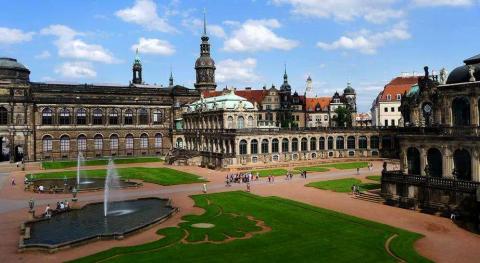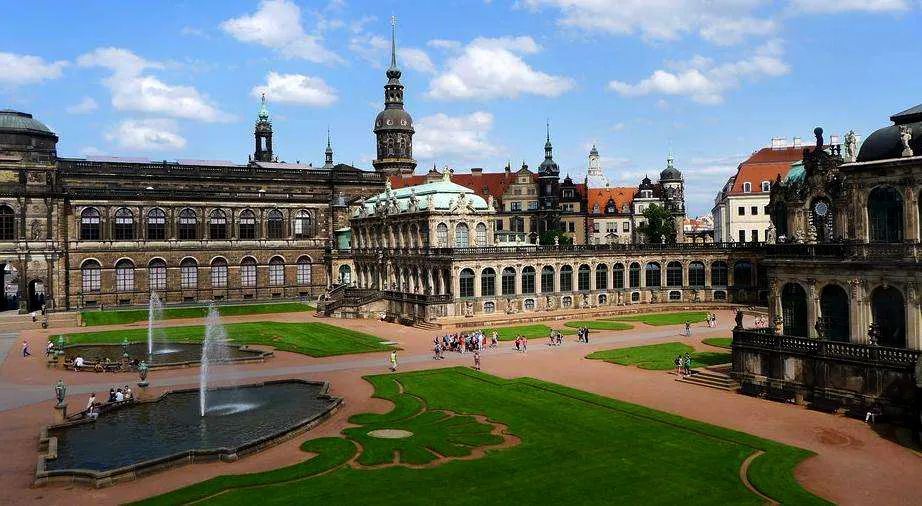

Zwinger Palace (picture from the Internet)
On the first weekend after our arrival, we went to visit the former royal palace Zwinger Palace and the famous Semper Opera House, and spent an afternoon in the Gallery of Classical Masters. That afternoon, the weather was fine. My roommate Ying and I drank coffee in the cafe opposite the Semper Opera House and watched people coming and going in the square. There are often piano players playing the piano in the square, and the gentle sound of the piano adds romance to the city. Many silver-haired couples dressed in colorful and harmoniously matched clothes slowly passed by hand in hand, feeling warmly moved in their hearts. Here I also met an old man and his wife who taught German at Tongji University in the 1980s. They had a simple exchange with the old man who spoke Chinese, and a sense of intimacy arose spontaneously as if meeting an old friend in a foreign country.

Zwinger Palace, known as the pinnacle masterpiece of Baroque architecture

Small bands can be seen everywhere in front of the Zwinger Palace

An old man playing the piano in front of the square

A city where music is everywhere—a young man playing the piano in front of the opera house

Silver-haired couple holding hands

I met an old man who once taught at Tongji University in Shanghai.
"Human" is an interesting and eternal theme. The Classical Masters Gallery contains more than 760 paintings by European masters of the Renaissance in the 16th century. During this period, the spirit of humanism broke through the God-centered imprisonment of the Middle Ages and brought about the liberation of human nature, and the value and dignity of human beings were fully affirmed. Hundreds of oil paintings here, mainly portraits, vividly demonstrate the beauty of people as the creators of real life, especially the beauty of women. The plump and round skin exudes golden luster; the eyes shining like stars, insight into what is in front of you. everything. "The Sleeping Venus", one of the world's top ten famous paintings, is an oil painting on canvas created by Italian Renaissance art master Giorgione in 1510. The painting shows Greek mythology The scene of CupidVenus sleeping naked. Giorgione did not complete the painting, and his younger brother Titian completed the landscape and sky.

"Sleeping Venus" depicts Venus as pure and flawless, and the beauty of her shape reaches a state that cannot be described in words.
Almost every visitor will stop in front of the museum's treasure, the Sistine Madonna. This masterpiece by Italian painter Raphael, one of the three great masters of the Renaissance, has attracted an endless stream of visitors. The beautiful and gentle Virgin holds Christ in her arms, ready to sacrifice her beloved Son to all mankind. Although I don’t have an in-depth understanding of painting, “beauty” is the common spiritual wealth of all mankind. It transcends national boundaries, language and knowledge. It seems that under the concentrated gaze, you can also find a common spiritual world with the characters in the painting.

"Sistine Madonna"
The Semper Opera House is a great Renaissance-style building. Suffering from fires and wars for more than two hundred years, the Opera House closed in August 1944 and was attacked by Allied air raids six months later. After World War II, Nirvana was rebuilt in 1985 and has undoubtedly become one of the most beautiful opera houses in the world. This opera house, named after its architect Gottfried Semper, is famous both for its gorgeous architectural appearance, its rich interiors of stone carvings, enamel paintings and exquisite murals, and its position in the history of music. It is a model for opera houses in Europe and around the world. As one of the oldest and most famous orchestras in the world, the Dresden Staatskapelle with a history of more than 460 years is based here. Music greats such as Wagner, Strauss, and Weber all played here. Later, we were lucky enough to enter this theater twice to watch the opera "Carmen" and a piano concert.

Sember Opera House

Before the performance at Semper Opera House

Colonnade in the Semper Opera House
Among the palace complex, the most noteworthy thing is the longest tile mural in the world, which is the 101-meter-long "Princes Expedition". The mural wall is made of 25,000 Meissen tiles. It was originally painted in 1876 and came out in 1907. It is very precious and is called an "unusual work of art." The mural delicately and vividly shows the kings of the Kingdom of Saxony from 1123 to 1876. Their names are marked under the statues of 35 equestrian kings. There are also 94 people including scientists, artists, craftsmen, soldiers, children and farmers from various eras, each of whom is lifelike. Fortunately, during the bombing of World War II, the surrounding area was in ruins. The buildings that have been restored today have all left traces of the war. Only this 100-meter-long wall stands intact and has become a living witness to that period of history. Not to mention it's a miracle.

The longest tile mural wall in the world, "Princes Expedition", I once stopped here for a long time, imagining many stories about this wall

The 101-meter-long world's longest tile mural wall is Dresden's wonder and pride

Cross Church, the blackened mark is a reflection on the war
The Germans love the legacies left by their ancestors and will not easily tear them down. Even if the war has blown them away, leaving only a pile of broken tiles and ruins, they still do not give up and use modern high-tech Technology was used to restore them, searching for usable stones in the ruins of the original site, and using computer analysis and positioning to put the stones back in place. That's why such a mottled and black building appeared, and everyone was deeply shocked.

The smoke and clouds of history have become a thing of the past. Let war stay away from mankind and let peace last forever in the world.
In every detail, we observed all aspects of German society and realized the huge improvement that Made in Germany has brought to socio-economic development and people's living standards, as well as the embodiment of the people-centered design concept in urban public facilities. Dresden is the city with the highest forest greening rate in Germany. Everywhere in the city is dressed in emerald green. Every household is planting flowers and keeping their courtyards neatly trimmed. In particular, the large garden opposite the classroom was originally the summer palace of August the Strong, but now it has become the best place for citizens to relax and exercise. Surrounded by forests, lakes, grasslands, and numerous exquisite carvings, many citizens enjoy lunch leisurely by the lake. Authentic German dark beer, a sausage, and a piece of potato are local delicacies.

The Great Garden was originally the summer palace of August the Strong

A favorite food among locals—grilled and fragrant German elbows

The easiest lunch ever: Dark beer with potatoes

This restaurant was one of Putin’s favorite restaurants when he was head of the KGB substation in Dresden from 1985 to 1990

Street scene: girl playing violin

Street scene: father and son immersed in music

Street Scenery: Mother and Son Cycling Fun

Street Scene: Happy Bride Encountered by Chance

Idyllic scenery outside the city of Dresden outside the car window

The suburban scenery outside the car window is a picture full of vitality.

The small mountain village outside Dresden is a dandelion’s dream

Quiet country house inhabited by people who are unconcerned with the world

The houses along the city streets are all dressed in green neon clothes

The houses on both sides of the street each have their own characteristics, and no one is the same.

There are no high-rise buildings in Dresden, and the most residential buildings are three-story buildings like this.

Trams are the most convenient urban transportation
Germans live a simple and simple life, and the consumption level in large shopping malls is not high. It is a society in which everyone is highly self-disciplined. For example, you need to buy your own tickets when taking public transportation, and there is no one to check the tickets. However, once you are randomly checked, you risk high fines and loss of credit. Small but fully functional apartment kitchens need to strictly abide by the rules of not turning on high heat for stir-frying, otherwise the automatic fire alarm will sound.

Apartment kitchen is small but functional
The life of the Germans seems to be unhurried and relaxed. On weekends, the cafes in the city center are full of people. A simple cup of coffee or a bottle of beer may be just an afternoon of leisure. Behind this is the focused and down-to-earth spirit of the Germans. They have no unrealistic dreams. Once the goal is set, one may focus on doing one thing well for the rest of his life. With this spirit and perseverance, the Germans allowed this city, which once wept in the smoke of the flames of World War II, to restore its past peerless beauty in 2006, the 800th anniversary of its founding. The Germans have carefully passed down all the buildings with historical value in this city from generation to generation, making them a symbol of national pride and peace.

Street cafe – people enjoying weekend time


Zwinger Palace moat

The symbol of Dresden: the moat arch is decorated with a golden crown symbolizing the royal power of Poland. August II ruled Poland as King of Poland from 1734 to 1763.

The "Blue Miracle Bridge", built from 1891 to 1893, was the first pierless bridge in Europe. Its steel truss structure was regarded as a technological miracle at the time and was named after the sky blue painted on the iron bridge.
